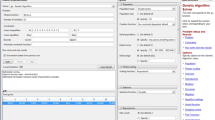Abstract
Cellular manufacturing (CM) has emerged as an alternative to conventional batch-type manufacturing owing to the former's capability of reducing set-up times, in-process inventories and throughput times. It provides the basis for implementation of just-in-time (JIT) and flexible manufacturing systems (FMS). The machine-part group formation is an important issue in the design of CMSs. This paper presents objective functional clustering algorithms for cell formation problems in the design of cellular manufacturing systems. A deterministic objective functional algorithm (hard clustering) and a fuzzy objective functional algorithm (fuzzy clustering) are used to form the part families and machine cells simultaneously. A collection of data sets from open literature is used to test these algorithms. A software package has been developed to verify the implementation.
Similar content being viewed by others
References
A. Kusiak and W. S. Chow, “Efficient solving of the group technology problem”,Journal of Manufacturing Systems,6(2), pp. 1081–1100, 1987.
K. R. Kumar, A. Kusiak and A. Vannelli, “Grouping of parts and components in flexible manufacturing systems”,European Journal of Operations Research”,24, pp. 387–397, 1986.
R. J. Schonberger,Japanese Manufacturing Techniques: Nine Hidden Lessons in Simplicity. The Free Press, New York, 1982.
F. F. Boctor, “A linear formation of the machine-part cell formation problem”,International Journal of Production Research,29, pp. 343–356, 1991.
G. Srinivasan, and T. T. Narendran, “GRAFICS-a nonhierarchical clustering algorithm for group technology”,International Journal of Production Research,29, pp. 463–478, 1991.
C. J. McCormick, D. W. Sweitzer and T. R. White, “Problem decomposition and data reorganisation by a clustering technique”,Operations Research,20, pp. 993–1009, 1972.
J. R. King, “Machine-component grouping in production flow analysis: an approach using rank order clustering”,International Journal of Production Research,18, pp. 213–232, 1980.
J. R. King and V. Nakornchai, “Machine component group formation in group technology-review and extension”,International Journal of Production Research,20, pp. 117–133, 1982.
M. P. Chandrasekaran and R. Rajagopalan, “MODROC-An extension of rank order clustering for group technology”,International Journal of Production Research,24, pp. 1221–1233, 1986.
H. M. Chan and D. A. Milner, “Direct clustering algorithm for group formation in cellular manufacture”,Journal of Manufacturing Systems,1, pp. 65–74, 1982.
H. C. Co and A. Arrar, “Configuring cellular manufacturing systems”,International Journal of Production Research,26, pp. 1511–1522, 1988.
A. Kusiak, “The part families problem in flexible manufacturing systems”,Annals of Operations Research,3, pp. 279–300, 1985.
J. McAuley, “Machine grouping for efficient production”,Production Engineer,51, pp. 53–57, 1972.
A. S. Carrie, “Numberical taxonomy applied to group technology and plant layout”,International Journal of Production Research,11, pp. 399–416, 1973.
P. H. Waghodekar and S. Sahu, “Machine-component cell formation in group technology: MACE”,International Journal of Production Research,22, pp. 937–948, 1984.
C. Mosier and L. Taube, “Weighted similarity measure heuristics for group technology clustering problem”,Omega,13, pp. 381–391, 1985.
A. Kusiak, “The generalised group technology concept”,International Journal of Production Research,25, pp. 561–569, 1987.
L. Stanfel, “Machine clustering for economic production”,Engineering Costs and Production Economics,9, pp. 73–81, 1985.
M. P. Chandrasekaran and R. Rajagopalan “An ideal seed nonhierarchical clustering algorithm for cellular manufacture”,International Journal of Production Research,24, pp. 451–464, 1986.
J. B. McQueen, “Some methods for classification and analysis of multivariate observations”, Proceedings of the Fifth Symposium on Mathematical Statistics and Probability, University of California, Berkeley, pp. 281–297, 1967.
M. P. Chandrasekaran and R. Rajagopalan, “ZODIAC—an algorithm for concurrent formation of part-families and machine-cells”,International Journal of Production Research,25, pp. 835–850, 1987.
R. Rajagopalan and J. L. Batra, “Design of cellular production systems — a graph theoretic approach”,International Journal of Production Research,13, pp. 567–579, 1975.
A. Vannelli and K. R. Kumar, “A method for finding minimal bottleneck cells for grouping part-machine families,International Journal of Production Research,24, pp. 387–400, 1986.
K. R. Kumar and A. Vannelli, “Strategic subcontracting for efficient disintegrated manufacturing”,International Journal of Production Research,3, pp. 279–300, 1987.
F. Choobineh “A framework for the design of cellular manufacturing systems”,International Journal of Production Research,26, pp. 1161–1172, 1988.
K. Raja Gunasingh and R. S. Lashkari, “Machine grouping problem in cellular manufacturing systems — an integer programming approach”,International Journal of Production Research,27, pp. 14675, 1989.
G. Srinivasan, T. T. Narendran and B. Mahadevan, “An assignment model for the part-families problem in group technology”,International Journal of Production Research,28, pp. 145–152, 1990.
H. J. Steudel and A. Ballakur, “A dynamic programming based heuristic for machine grouping in manufacturing cell formation”,Computers and Industrial Engineering,12, pp. 215–222, 1987.
J. C. Bezdeck,Pattern Recognition with Fuzzy Objective Function Algorithms, New York, Plenum Press, 1981.
M. R. Anderberg,Cluser Analysis for Application, New York, Academic Press, 1973.
A. J. Vakhria and U. Wemmerlov, “A new similarity index and clustering methodology for formation of manufacturing cells”,DSI Proceedings,2, pp. 1075–1077, 1988.
R. Panneerselvam and K. N. Balasubramanian, “Algorithmic grouping of operation sequences”,Engineering Costs and Production Economics,9, pp. 125–135, 1985.
C.-H. Chu and J. C. Hayya, “A fuzzy clustering approach to manufacturing cell formation”,International Journal of Production Research,29, pp. 1475–1487, 1991.
J. A. Ventura, F. Frank Chen and C.-H. Wu, “Grouping parts and tools in flexible manufacturing systems production planning”,International Journal of Production Research,28, pp. 1039–1056, 1990.
C. Mosier and L. Taube, “The facets of group technology and their impacts on implementation — a state of the art survey”,Omega,17, pp. 289–295, 1985.
H. Seiffidini, “Single linkage vs average linkage clustering in machine cells formation applications”,Computers and Industrial Engineering,16, pp. 419–426, 1989.
Author information
Authors and Affiliations
Rights and permissions
About this article
Cite this article
Ponnambalam, S.G., Aravindan, P. Design of cellular manufacturing systems using objective functional clustering algorithms. Int J Adv Manuf Technol 9, 390–397 (1994). https://doi.org/10.1007/BF01748484
Issue Date:
DOI: https://doi.org/10.1007/BF01748484




